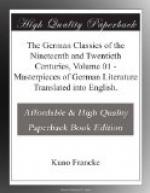If, therefore, the struggle with the language was fought out successfully by modern German literature only on the battleground of the lyric (and even there, as we have seen, not without exceptions), on the other hand a second conservative force was placed at the service of the literary development with more uniform success, namely Metrics. To be sure, here again this applies only to verse, for the corresponding art of prose rhythm has been as good as lost to the Germans, in contrast to the French, and almost more so to the English. In prose also a conscious and systematic attempt to make an artistic division into paragraphs, chapters, and books, has only been made in recent times, above all in and since the writings of Nietzsche. For as far as the treatment of language in itself is concerned, German literature has hardly yet fully developed an artistic form; writers still continue to treat it far too much as a mere tool. But verse is felt to be an object for artistic molding, although here too the naturalistic dogmas of the Storm and Stress writers, of the Romanticists, Young Germans and Ultra-Moderns, have often shaken the theories upon which the artistic perfection of our poetry is based.
In this regard, likewise, there was, in the seventeenth century, a great difficulty to be overcome. Changes in language, the effect of French and Italian style, the influence of music, had weakened the foundations of the German art of verse, which were already partly broken down by mechanical wear and tear. The comparatively simple regulation contrived by an ordinary, though clever, poet, Martin Opitz, proved capable of enduring for centuries; a connection was established between the accent of verse and natural accent, which at the same time, by means of more stringent rules, created barriers against variable accent. It was merely a question of arranging the words in such fashion that, without forming too great a contradiction to the common-place order of words, the way in which the accents were placed upon them should result in a regularly alternating rise and fall. On the whole, this principle was found to be sufficient until the enthusiasm of the new poetic generation demanded a closer connection between the poetic form and the variable conditions of the soul; they found a way out of the difficulty by carrying a rhythmical mood through a variety of metrical divisions, and thus came upon the “free rhythms.” From whatever source these were derived, either from the misunderstood poems of Pindar, from the language of the Bible or of the enthusiastic mystics, or from the poetic half-prose of the pastoral poet Salomon Gessner, they were, in any case, something new and peculiar, and their nature has not been grasped in the least degree by the French in their “vers libres,” or at any rate only since the half-Germanic Fleming Verhaeren. They received an interesting development through Goethe and Heinrich Heine, while most of the other poets who made use of them, even the greatest one, Novalis, often deteriorated either into a regular, if rhymeless, versification, or into a pathetic, formless prose.




